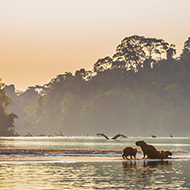Harmful pharmaceuticals found in world's rivers

Rivers included in the study included the Amazon, Mississippi, Thames and the Mekong.
Pharmaceuticals at potentially toxic levels are present in more than 250 of the world’s rivers, according to research by the University of York.
The study published in Proceedings of the National Academy of Science (PNAS) looked at 258 rivers across the globe to measure the presence of 71 pharmaceuticals, including metformin, caffeine and carbamazepine.
It found that pharmaceutical pollution is contaminating water on every continent, with strong correlations between the socioeconomic status of a country and higher pollution of pharmaceuticals in its rivers.
The study also found that high levels of pharmaceutical pollution were most positively associated with regions of high median age, as well as local high unemployment and poverty rates.
Rubbish dumping along river banks, inadequate wastewater infrastructure and pharmaceutical manufacturing were cited as the activities most associated with the highest levels of pharmaceutical pollution.
Project co-leader Dr John Wilkinson, from the University's department of environment and geography, described the study as an “excellent example of how the global scientific community can come together to tackle large-scale environmental issues”.
He added: "We’ve known for over two decades now that pharmaceuticals make their way into the aquatic environment where they may affect the biology of living organisms. But one of the largest problems we have faced in tackling this issue is that we have not been very representative when monitoring these contaminants, with almost all of the data focused on a select few areas in North America, Western Europe and China.
"Through our project, our knowledge of the global distribution of pharmaceuticals in the aquatic environment has now been considerably enhanced. This one study presents data from more countries around the world than the entire scientific community was previously aware of 36 new countries to be precise where only 75 had ever been studied before."
Researchers hope that through enhancing the monitoring of pharmaceuticals in the environment, they will be able to devise measures to restrict the consequences these contaminants may have.
Rivers included in the study included the Amazon, Mississippi, Thames and the Mekong.



 BSAVA is to partner with BVA Live (11-12 June 2026) to champion clinical research.
BSAVA is to partner with BVA Live (11-12 June 2026) to champion clinical research.